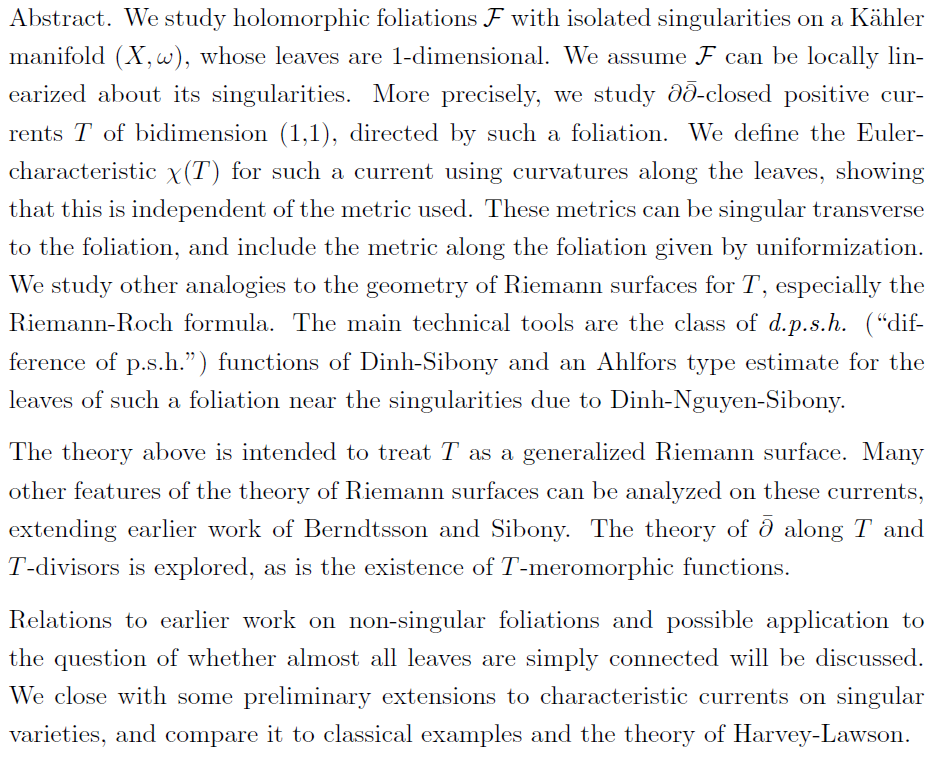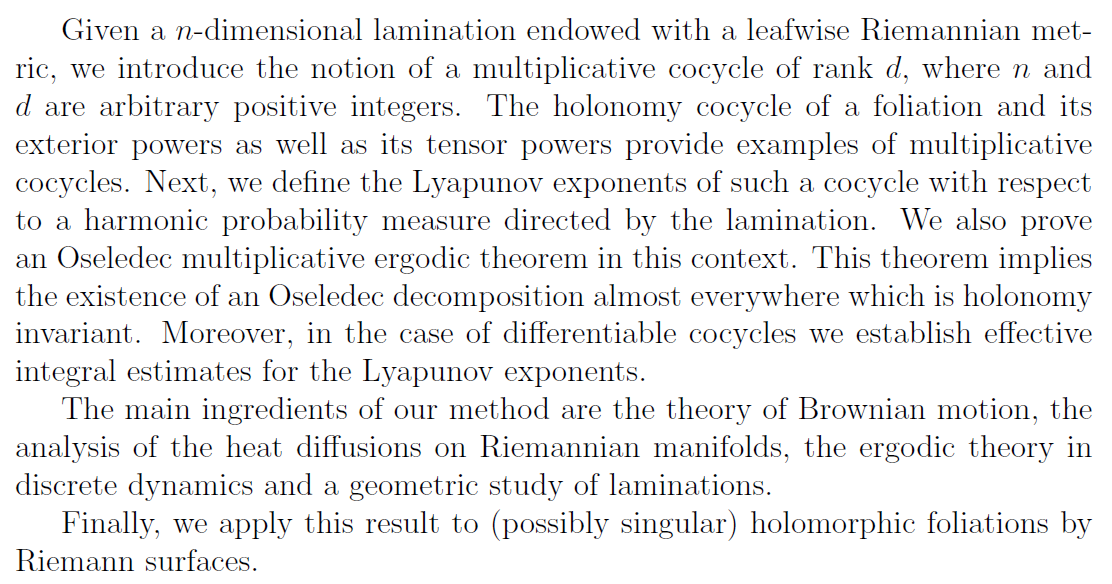Workshop in Dynamics and Geometry
Date: Aug. 17 ~ Aug. 21/ Place: Rm. 1503, KIAS, Seoul, Korea |

| Title & Abstract | Home > Title & Abstract |
Speaker: Bo Berndtsson (University of Chalmers)
Title: Transcendental Brunn-Minkowski inequalities: Theory and applications
Abstract: TBA
Speaker: Daniel Burns (University of Michigan)
Title: Harmonic currents along a foliation as generalized Riemann Surfaces
Abstract:

Speaker: Tien-Cuong Dinh (National University of Singapore)
Title: Equidistribution speed for Fekete points associated with an ample line bundle
Abstract: Let K be a compact subset with smooth boundary in C^n. A Fekete configuration of order p for K is a finite subset of K maximalizing the Vandermonde determinant associated with polynomials of degree p or less than p. A recent theorem by Berman, Boucksom and Witt Nystr?m implies that Fekete configurations for K are asymptotically equidistributed with respect to a canonical equilibrium measure for K when p tends to infinity. We give an explicit estimate for the speed of convergence. The result also holds in a general setting of Fekete points associated with an ample line bundle over a projective manifold. This is a join work with Xiaonan Ma and Viet-Anh Nguyen.
Speaker: Joel Merker (University Paris-Sud)
Title: On a conjecture of Shoshichi Kobayashi, and on a conjecture of Olivier Debarre
Abstract: In 1970, Shoshichi Kobayashi conjectured that generic projective hypersurfaces X^n in P^{n+1}(C) of degree high enough are hyperbolic. Equivalently by Brody 1978, there exist no nonconstant entire holomorphic curves f : C --> X^n. The natural strategy is to differentiate such f, and to obtain enough holomorphic jet differentials satisfied by these f so as to force them to be constant.
After Masuda-Noguchi 1996, Siu-Yeung 1997, Shirosaki 2000, Shiffmann-Zaidenberg 2002 and Duval 2004, Dinh Tuan Huynh, Ph. D. Student in Orsay University, exhibited families of hyperbolic hypersurfaces of degree 2(n-1) in P^{n+1}(C) for 2 <= n <= 5.
Recently, some progresses on Kobayashi's conjectured have been made.
Yet, an appropriate control of the base locus of jet differentials remains a challenging open difficulty. The talk will list a few deep reasons why this ancient problem still resists.
A more ambitious conjecture, inspired by Debarre 2005 for jets of order 1, expects that the concerned jet bundles are ample, namely have the highest number of mostly independent holomorphic sections.
In a breakthrough, Damian Brotbek 2014 established that generic complete intersections X^n in P^{n+c} with c >= 3n-2 all of whose degrees are >= 2(n+c)+3, have ample cotangent bundles. Incidentally, this result is based on a rich and clever construction of symmetric differentials.
Generally, Debarre's 2005 conjecture expects ampleness for any c >= n, and it was recently established in degrees >= n^{n^3} by Songyan Xie, Ph. D. student in Orsay University.
The talk will mainly present coordinate constructions of negatively twisted holomorphic jet differentials on certain Fermat-Masuda-Noguchi families of hypersurfaces X^n in P^{n+c}(C) for which base locus emptyness can be obtained, by means of new determinantal computations.
Once ampleness of higher order jet bundles will be shown to be stable under perturbation (as is known in order 1), generic ampleness of jet bundles, hence Kobayashi's conjecture, will be established.
Speaker: Viet-Anh Nguyen (University Paris-Sud)
Title: Brownian motion on laminations, Lyapunov exponents and applications
Abstract:

Speaker: Keiji Oguiso (University of Osaka)
Title: Simple abelian varieties and primitive automorphisms of null entropy of surfaces
Abstract: We characterize simple complex abelian varieties and simple abelian surfaces in terms of primitivity of translation automorphisms. Applying this together with a result due to Diller and Favre, we then classify all primitive birational automorphisms with trivial first dynamical degree of smooth projective surfaces over an algebraically closed field of any characteristic.
Speaker: Yong-Geun Oh (POSTECH & IBS CGP)
Title: Holomorphic discs, tropicalizations and non-displaceable Lagrangian tori
Abstract: In this talk, I will first explain how we construct the generating function of the counting numbers of holomorphic discs for the Lagrangian torus fibers of toric manifolds and its deformations, especially by the toric divisors to detect the fibers nondisplaceable by Hamiltonian isotopy of toric manifolds. Then we will describe what FOOOcall `bulk-balanced Lagrangian torus fibers' as the intersections of certain collection of tropical curves selected purely in terms of the associated moment polytope. My lecture is based on joint work with Fukaya-Ohta and Ono (for the first part), and also on the work of my two graduate students, Yoosik Kim and Jaeho Lee (for the latter part).
Speaker: Hossein Raufi (University of Wuppertal)
Title: Singular hermitian metrics on holomorphic vector bundles
Abstract: We introduce and discuss the notion of singular hermitian metrics on holomorphic vector bundles, following Berndtsson and Paun. We define what it means for such metrics to be positively and negatively curved in the sense of Griffiths and investigate the assumptions needed in order to locally define the curvature as a matrix of currents. We then proceed to show that such metrics can be regularised in such a way that the corresponding curvature tensors converge weakly as currents.
Speaker: Misha Verbitsky (National Research University HSE, Moscow)
Title: Gromov-Hausdorff metric on the space of hyperkahler structures
Abstract: The space H of hyperkahler metrics on a given complex manifold is itself a metric space, equipped with the Gromov-Hausdorff metric(the distance between two metric spaces is given by infinum of the distortion of the metric for all maps from one to another). Using the ergodicity of the diffeomorphism group action, it was shown that a closure of H contains hyperkahler metrics for all deformations of the complex structure on M. This result is geometrically very striking, because it implies that the boundary of the Kahler cone (in Gromov-Hausdorff topology) is of much bigger dimension than the cone itself. I will explain how to use this construction to study the geometry of the Kahler cone. Among the other applications, this is used to prove that any hyperkahler manifold with b_2 > 3 admits a nef cohomology class of zero volume.
